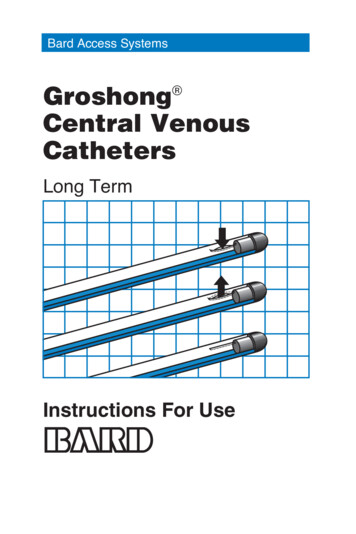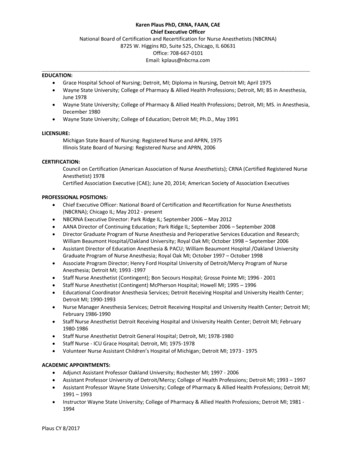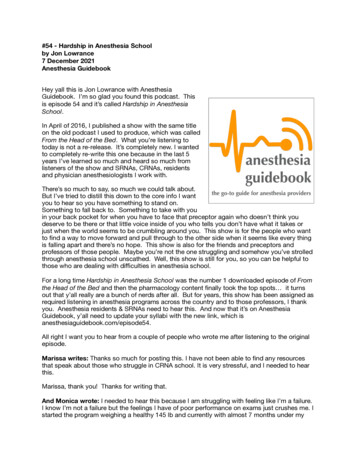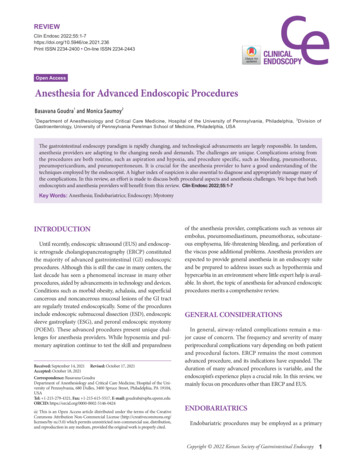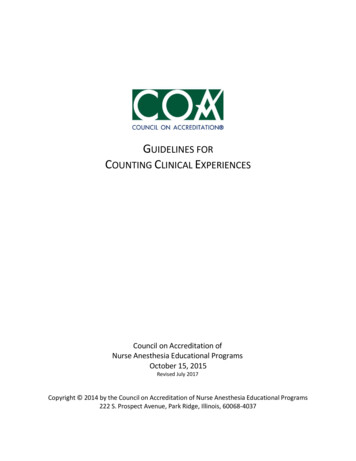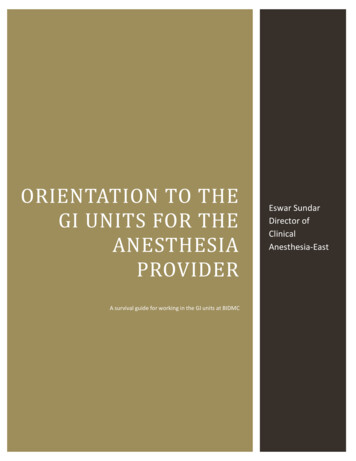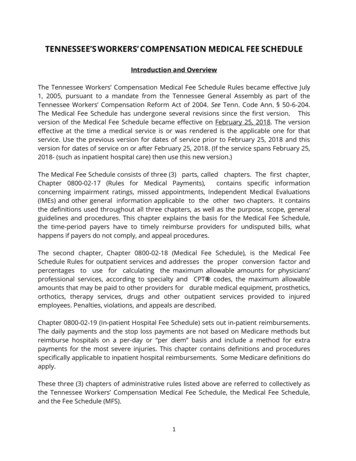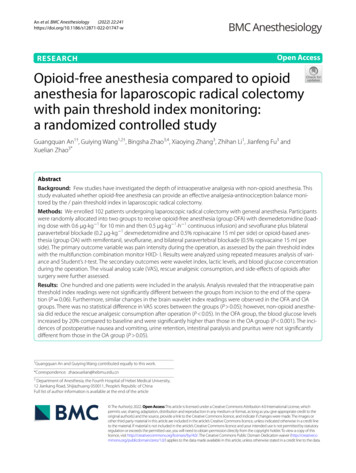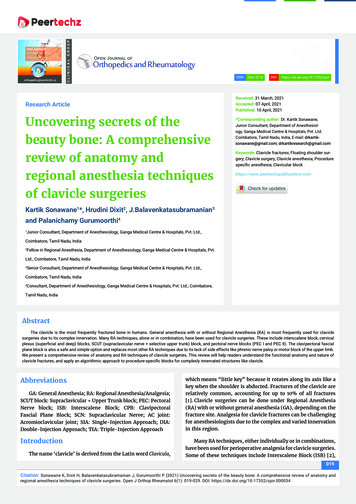
Transcription
CLINICALGROUPvvISSN: ved: 31 March, 2021Accepted: 07 April, 2021Published: 10 April, 2021Research ArticleUncovering secrets of thebeauty bone: A comprehensivereview of anatomy andregional anesthesia techniquesof clavicle surgeries*Corresponding author: Dr. Kartik Sonawane,Junior Consultant, Department of Anesthesiology, Ganga Medical Centre & Hospitals, Pvt. Ltd.Coimbatore, Tamil Nadu, India, E-mail:Keywords: Clavicle fractures; Floating shoulder surgery; Clavicle surgery; Clavicle anesthesia; Procedurespecific anesthesia; Clavicular blockhttps://www.peertechzpublications.comKartik Sonawane1*, Hrudini Dixit2, J.Balavenkatasubramanian3and Palanichamy Gurumoorthi4Junior Consultant, Department of Anesthesiology, Ganga Medical Centre & Hospitals, Pvt. Ltd.,1Coimbatore, Tamil Nadu, IndiaFellow in Regional Anesthesia, Department of Anesthesiology, Ganga Medical Centre & Hospitals, Pvt.2Ltd., Coimbatore, Tamil Nadu, IndiaSenior Consultant, Department of Anesthesiology, Ganga Medical Centre & Hospitals, Pvt. Ltd.,3Coimbatore, Tamil Nadu, IndiaConsultant, Department of Anesthesiology, Ganga Medical Centre & Hospitals, Pvt. Ltd., Coimbatore,4Tamil Nadu, IndiaAbstractThe clavicle is the most frequently fractured bone in humans. General anesthesia with or without Regional Anesthesia (RA) is most frequently used for claviclesurgeries due to its complex innervation. Many RA techniques, alone or in combination, have been used for clavicle surgeries. These include interscalene block, cervicalplexus (superficial and deep) blocks, SCUT (supraclavicular nerve selective upper trunk) block, and pectoral nerve blocks (PEC I and PEC II). The clavipectoral fascialplane block is also a safe and simple option and replaces most other RA techniques due to its lack of side effects like phrenic nerve palsy or motor block of the upper limb.We present a comprehensive review of anatomy and RA techniques of clavicle surgeries. This review will help readers understand the functional anatomy and nature ofclavicle fractures, and apply an algorithmic approach to procedure-specific blocks for complexly innervated structures like clavicle.AbbreviationsGA: General Anesthesia; RA: Regional Anesthesia/Analgesia;SCUT block: Supraclavicular Upper Trunk block; PEC: PectoralNerve block; ISB: Interscalene Block; CPB: ClavipectoralFascial Plane Block; SCN: Supraclavicular Nerve; AC joint:Acromioclavicular joint; SIA: Single-Injection Approach; DIA:Double-Injection Approach; TIA: Triple-Injection ApproachIntroductionThe name ‘clavicle’ is derived from the Latin word Clavicula,which means “little key” because it rotates along its axis like akey when the shoulder is abducted. Fractures of the clavicle arerelatively common, accounting for up to 10% of all fractures[1]. Clavicle surgeries can be done under Regional Anesthesia(RA) with or without general anesthesia (GA), depending on thefracture site. Analgesia for clavicle fractures can be challengingfor anesthesiologists due to the complex and varied innervationin this region.Many RA techniques, either individually or in combinations,have been used for perioperative analgesia for clavicle surgeries.Some of these techniques include Interscalene Block (ISB) [2],019Citation: Sonawane K, Dixit H, Balavenkatasubramanian J, Gurumoorthi P (2021) Uncovering secrets of the beauty bone: A comprehensive review of anatomy andregional anesthesia techniques of clavicle surgeries. Open J Orthop Rheumatol 6(1): 019-029. DOI: https://dx.doi.org/10.17352/ojor.000034
n-journal-of-orthopedics-and-rheumatologycombined ISB with superficial cervical plexus block [3], cervicalnumber, having two primary ossification centers, two borders,plexus block [4], a combination of supraclavicular nerve andtwo curvatures, two ends, two surfaces, and two articulations/upper (superior) trunk (SCUT) block [5], a combination of ajoints. (Figure 1A).pectoral nerve (PEC) I block with selective supraclavicularnerve block [6], modified PEC II block [7] and Clavipectoral Fascial Plane Block [8-11] (CPB). We present a comprehensivedevelopment of the embryo (5th-6th weeks of gestation)review of the clavicle anatomy, its innervation, and differentand one of the last bones to finish ossification (21-25RA techniques used for clavicle surgeries.KnowledgeoffunctionalanatomyTwo primary ossification centers: The clavicle is thefirst bone to begin the ossification process during theyears of age).andthesurgicalprocedure helps in planning the procedure-specific RA technique for the patient. There is a paucity of literature ontrapezius muscle in the lateral 1/3rd, respectively.the innervations, associated pathologies, and optimal RAtechniques for clavicle fractures. This review will help readersunderstand the clavicle anatomy and nature of fractures and the clavicle.complexly innervated structures like clavicle. sternal end is round, pyramidal-like, and formedby endochondral ossification.bone” because of its prominent body location. It is the onlylong bone that lies horizontally in the body. The shape of theTwo ends: The lateral acromial end is broad, flat, andformed by intramembranous ossification. The medialThe clavicle, or collarbone, is also referred to as “beautyclavicle appears elongated ‘S’ due to its unique anterior andTwo curvatures: The anterior curvature in the medial2/3rd and the posterior curvature in the lateral 1/3rd ofapply an algorithmic approach to procedure-specific blocks forFunctional anatomy of clavicleTwo borders: The anterior and the posterior bordersgive origin to the deltoid muscle and insertion to the Two surfaces:posterior curvatures. It can appear long and slender, thick and1. Superior surface: It has a smooth appearance bearingshort, or any combination due to its complex shape. It consiststhe acromial facet at the acromial end to form anof spongy cancellous bone within the compact bone shell,acromioclavicular joint. The superior surface of theforming a periosteal collar. It is the only membranous bonemedial 2/3rd of the clavicle gives origin to the clavicularoutside the skull and is uniquely pierced through-and-throughhead of the sternocleidomastoid. It is covered byby the Supraclavicular Nerve (SCN) [12]. Thus, it is also referredplatysma muscle under which the supraclavicular nervesto as dermal bone. It follows the “rule of two,” i.e., two inlie, providing sensory innervation to the overlying skin.Figure 1: Functional anatomy of the clavicle, classification of clavicle fracture and fascias related to the clavicleA: Various borders, surfaces, ends, processes, and bony landmarks of the clavicleB: Classification of the clavicular fracturesC: Various fascias related to the clavicle020Citation: Sonawane K, Dixit H, Balavenkatasubramanian J, Gurumoorthi P (2021) Uncovering secrets of the beauty bone: A comprehensive review of anatomy andregional anesthesia techniques of clavicle surgeries. Open J Orthop Rheumatol 6(1): 019-029. DOI: https://dx.doi.org/10.17352/ojor.000034
n-journal-of-orthopedics-and-rheumatology2. Inferior surface: It is rough, with many prominentlinesformedduetomusclesand away from the trunk by providing a stable strut betweenattachment. It has three bony landmarks: the sternalthe arm and the axial skeleton. It allows the musclesto generate adequate power to perform reaching andelevation tasks.facet forming the sternoclavicular joint, the costaltuberosity for the costoclavicular, and the conoidtubercle for conoid ligaments attachments. Two Articulations/Joints: It is also called a ‘double planejoint’ as a layer of articular cartilage separates two jointcavities.1.Acromioclavicular (AC) joint is a plane synovialjoint formed by the acromial end of the clavicleand the acromion of the scapula, connected bythe acromioclavicular ligament. It supports the functionof muscles that move the vialjoint formed by the sternal end of the clavicle . The anterior interclavicular ligament preventsclavicle dislocation upon shoulder depression, whereasthe posterior interclavicular (costoclavicular) ligamentprevents clavicle dislocation upon shoulder elevation.Primarily, it allows elevation and depression of theshoulder joint. Blood supply to the clavicle is mainlyderived from the thoracoacromial and suprascapulararteries, and rarely from the internal mammary artery.There is a rich blood supply in the middle third and nosupply on the posterior or inferior surfaces, leading toan increased risk of nonunion in high-energy midshaftfractures. The detailed innervation of the clavicle isdiscussed in the later section of this article.Variations Males have longer and more massive clavicles thanfemales. The right clavicle is usually stronger and shorter thanthe left clavicle [13,14]. An autosomal dominant congenital disability likecleidocranial dysplasia is associated with a partly orcompletely absent clavicle.The levator claviculae muscle is present in 2–3% of people.It originates from the upper cervical vertebrae’s transverseprocesses and inserts over the lateral half of the clavicle [15,16].Functions of the clavicle [17] Acts as a strut: The clavicle helps to position the armligamentousAdaptation to perform tasks: The well-developedclavicles and scapulae in humans and other brachiatingmammals are an adaptation to perform tasks usinghands well away from the body and climb, swing andgrasp distant objects.Scapular rotation: Out of the total 60 rotation of thescapula during the abduction of the arm, 30 comespurely from the lateral clavicle, and the remaining 30 comes from angulation of the whole clavicle and scapulatogether at the sternoclavicular joint.Fascias related to the clavicle (Figure 1C)Deltoid fascia: It is a fibrous membrane over the outer aspectof the deltoid muscle. Superiorly, it is attached to the clavicle,acromion, and the crest of the scapular spine. Inferiorly, it iscontinuous with the brachial fascia of the arm. Posteriorly, it iscontinuous with the posterior infraspinatus fascia. Anteriorly, itunifies with the pectoral fascia at its frontal-most edge.Pectoral fascia: It is a thin layer of fascia covering thepectoralis major muscle. It is attached medially to the sternumsuperiorly to the clavicle, and inferolaterally, it is continuouswith the fascia of the thorax, shoulder, and axilla. At its mostlateral section, it forms the floor of the axilla as the axillaryfascia.Axillary fascia: The classic bowl-like appearance of thearmpit results primarily via the action of axillary fascia intethering the skin to the floor of the axilla. It is frequentlyreferred to as the suspensory ligament of the axilla. In females,it is pierced by the tail of the breast (aka the tail of Spence).This fascia surrounds the latissimus dorsi muscle laterally andenvelops the pectoralis minor muscle medially before becomingthe clavipectoral fascia at the upper edge of it.Clavipectoral fascia: The clavipectoral fascia is astrong fascia situated posterior to the clavicular part ofthe pectoralis major muscle. It extends superiorly fromthe clavicle, medially from the costochondral joints,and superolaterally from the coracoid process. Inferiorly, itconverges in the axilla, where it acts as a protective structureover the neurovascular structure of the axilla. It lies betweenthe pectoralis minor and subclavius muscles, protectingthe axillary nerve and vessels. Superiorly, it splits to enclose thesubclavius muscle before attaching to the clavicle. Its posteriorlayer fuses with the deep cervical fascia, which connectsthe omohyoid muscle to the clavicle. Medially, it is attachedto the first rib before blending with the fascia over the firsttwo intercostal spaces. Laterally, it is attached to the coracoidprocess before blending with the coracoclavicular ligament.The fascia often thickens to form a whiter and denser band,the costocoracoid ligament/membrane, between the first riband coracoid process. Inferiorly, the fascia becomes thin, splitsaround pectoralis minor, and descends to blend with the axillaryfascia and laterally with the fascia over the short head of biceps.It is pierced by CALL [cephalic vein, artery (thoracoacromial),lateral pectoral nerve, lymphatics]. The clavipectoral fasciacompletely surrounds the clavicle, and the nerve endings of theclavicle penetrate this fascia [18].021Citation: Sonawane K, Dixit H, Balavenkatasubramanian J, Gurumoorthi P (2021) Uncovering secrets of the beauty bone: A comprehensive review of anatomy andregional anesthesia techniques of clavicle surgeries. Open J Orthop Rheumatol 6(1): 019-029. DOI: https://dx.doi.org/10.17352/ojor.000034
n-journal-of-orthopedics-and-rheumatologyClavicle fracturesIncidence Clavicle fractures represent 5-10% of all fractures [19]and account for 35% of scapular girdle injuries [20]. There is a bimodal distribution of the clavicle fractures,with the two peaks being younger men (due to sportsinjury) and patients older than 55 years of age (due toosteoporosis and fall) [21]. Clavicle fractures are prevalent injuries in adults (25%) and children (10-15%) [22] and represent 44-66%of all shoulder fractures [23].Mechanism: Clavicle fractures are often caused by a direct impact onthe outer aspect of the shoulder, typically from a fall,injury and trauma in motor vehicle accidents or sports.Clavicle fractures represent 95% of fractures seenduring childbirth while passing through the birth canal[24].It can easily be fractured due to impact to the shoulderfrom the force of falling on outstretched arms or by adirect hit [25].ClassificationAllman classification system [26] is based on the anatomicallocation of the fracture, as shown in Figure 1B.A. Type I involves the middle third of the clavicle, whichconstitutes around 75% of all clavicular fractures. Beingthe region with the narrowest cross-sectional diameterand lack of muscular and ligamentous attachment, themiddle third of the clavicle becomes more vulnerableto the bending movements exerted by the structuresattached. They are generally stable but may be associatedwith significant deformity.B. Type II involves the lateral third of the clavicle andconstitutes around 20% of all clavicular fractures. Theyare more common in elderly patients or those with comorbidities, although they do occur in all age groups.When displaced, these types are often unstable.C. Type III involves the medial third of the clavicle andconstituting around 5% of all clavicular fractures. It iscommonly associated with multi-system polytrauma.It can be associated with neurovascular compromise,pneumothorax, or hemothorax.Associated injuriesNeurovascular injurya) Type I fractures are associated with injury to the SCN(intermediate branch), which pierces the clavicle in 1%to 4% of the population and innervates the proximalhalf of the clavicle [27].b) The ulnar nerve is the most commonly injured peripheralnerve in clavicle fractures as it is close to the middle andmedial third junction.c) The brachial plexus lies as close as 12 mm from themedial end of the clavicle [28]. Thus, direct injury tothe vessels and brachial plexus can occur at the timeof fracture or iatrogenically during surgery with 0-15%incidence [29,30].d) Vascular injury (due to fracture or surgery) leads toarteriovenous fistula formation, pseudoaneurysm, orair embolism.Polytrauma: TypeIIIfracturesareassociatedwithmulti-system polytrauma with neurovascular compromise,pneumothorax, or hemothorax.ManagementMost clavicle fractures can be treated conservatively asmost of them with significant deformity ( 90%) unite despitedisplacement. Conservative treatment options include using asling, ‘figure-of-eight’ bandage, and a well-supported elbowto improve the deformity. Early movement of the shoulderjoint is recommended to prevent the development of a frozenshoulder. Medial clavicle fractures need to be considered inthe broader context of associated injury, such as traumaticlung injury, and managed accordingly. Surgical interventionis mainly needed in open comminuted fractures, significantlyshortened fractures, and bilateral fractures to permit weightbearing. An open reduction and internal fixation will benecessary for fracture nonunion, usually performed at 2-3months post-injury.Types of clavicle surgeryThe standard surgical options of clavicle fractures includeopen reduction and plate fixation, intramedullary fixation (TENSnailing, Steinman pin application), tension band wiring mainlyfor AC joint disruption or lateral end fracture, simple screwfixation for less displaced fractures, and implant removal. All opensurgeries involve incision along the fracture line, whereas closedsurgeries (intramedullary fixation) typically use a smaller incision,usually away from the fracture site. Closed surgeries cause fewerdisturbances to the surrounding soft tissues. Clavicle surgeries aremainly done in a supine or modified beach-chair position, which isrelatively comfortable for all patients. Many centers prefer GA withor without RA due to complex innervations and lack of availableliterature about the most suitable techniques.RA techniques for clavicle surgeriesThe pain generating structures in clavicle surgeries includethe skin over the incision area and richly innervated periosteum.So, the planned RA technique should cover all the innervationsof these pain generators. Due to the complex innervation ofthe clavicle, a 3-step algorithmic approach, ‘Identify-SelectCombine’ [31] can be applied to determine the most suitableprocedure-specific RA option.022Citation: Sonawane K, Dixit H, Balavenkatasubramanian J, Gurumoorthi P (2021) Uncovering secrets of the beauty bone: A comprehensive review of anatomy andregional anesthesia techniques of clavicle surgeries. Open J Orthop Rheumatol 6(1): 019-029. DOI: https://dx.doi.org/10.17352/ojor.000034
on: Sonawane K, Dixit H, Balavenkatasubramanian J, Gurumoorthi P (2021) Uncovering secrets of the beauty bone: A comprehensive review of anatomy andregional anesthesia techniques of clavicle surgeries. Open J Orthop Rheumatol 6(1): 019-029. DOI: https://dx.doi.org/10.17352/ojor.000034
n-journal-of-orthopedics-and-rheumatologyFigure 2: Dermatomes, Myotomes, and Osteotomes of Clavicle.A: Dermatomal innervations of Clavicle (Source: nysora.com)B & C: Muscles and ligaments attached to the clavicle and their innervations(Source: Images is courtesy of 3D4Medical’s vEssential Anatomy App)D: Osteotomal innervations of the clavicle.Identifying target nerves for clavicle surgeryThe clavicle derives its sensory innervation from thecervical plexus and the brachial plexus. Due to the superficialand anterior location of the clavicle, all the innervations comefrom the anterior rami of the spinal nerves (C3-C7) without anycontribution from the posterior rami. The clavicle receives itsinnervation from the nerves lying in the vicinity, either supplyingskin, muscles, joints, or ligaments. The anterosuperior portionof the clavicle is bare and lies directly under the skin andsubcutaneous tissue. The cutaneous branches supplying skinover the clavicle, i.e., supraclavicular nerves, also supply theclavicle at different levels. The procedure-specific RA optionshould cover all essential innervations of skin (dermatomes),muscles (myotomes), and bone (osteotomes) of the clavicle(Figure 2) as per the surgery involved.The sensory innervation of the clavicle and the overlyingskin is not clearly identified, and it varies depending onthe source between C3 and C6 [4,32-34]. The C3-C5 rootscontribute to the dermatomal innervations, whereas the C3-C7roots contribute to the myotomal and osteotomal innervations.Four muscles arise from, and two muscles insert into theclavicle, as shown in Table 1.The periosteum of any bone is richly innervated by thenerve fibers that stem from different sources [33] like terminalbranches of motor nerves (‘Muscle-Areas’ of periosteum)and joint nerves (‘Capsule-Adjacent-Areas’), branches ofcutaneous nerves (‘Muscle-Free-Areas’), and branches ofnerves following nutrient arteries (‘Nutrient-ForaminaAreas’). Likewise, the osteotomal innervation [34] of theclavicle includes,1.“Muscle-Area”: Subclavian nerve (subclavius), spinalaccessory nerve and trapezius branch of cervical plexus(trapezius), and lateral pectoral nerve (pectoralismajor).2.Capsule-Adjacent-Area: Suprascapular nerve (AC iatesupraclavicular nerves (anterior and superior area).4.‘Nutrient-Foramina-Areas’: Lateral pectoral prascapular nerve (C5-C6) and lateral pectoral nerve (C5C7). The sternoclavicular joint is innervated by the medial SCN(C3-C4) in the superficial part and the nerve to subclavius (C5C6) in the deeper part.The target nerves to cover dermatomes, myotomes, andosteotomes of the surgical areas are shown in Table 2.Selecting procedure-specific target blocksA procedure-specific approach should be applied totarget specific nerves as per the surgical steps to involve theinnervation (Table 3) of all the pain generating components.Since all nerves supplying the clavicle enters the clavipectoralfascia surrounding it, it is possible to block these nerves bydepositing drug between this fascia and the periosteal collar.Such a fascial plane block is a relatively simple and safe optionavailable for awake clavicle surgeries.024Citation: Sonawane K, Dixit H, Balavenkatasubramanian J, Gurumoorthi P (2021) Uncovering secrets of the beauty bone: A comprehensive review of anatomy andregional anesthesia techniques of clavicle surgeries. Open J Orthop Rheumatol 6(1): 019-029. DOI: https://dx.doi.org/10.17352/ojor.000034
n-journal-of-orthopedics-and-rheumatologyThe target blocks, which can include all selected target Selectivesuperiortrunkblock selectivesupraclavicular nerve blocknerves, are as follows:A.Plexus blocksB.Dual-injection Approach (DIA): (Figure 3C, D) Interscalene block Clavipectoral fascial plane block Superficial cervical plexus blockC.Triple-injection Approach (TIA) Selective superior trunk block [35] Modified clavipectoral fascial plane block Selective supraclavicular nerve block [36].Although the most common RA technique used in claviclesurgery is interscalene block [2], it is not without its undesirableB.Fascial plane block Clavipectoral fascial plane blockeffects or complications, such as phrenic nerve palsy,recurrent laryngeal nerve block, Horner syndrome, total spinalanesthesia, and cardio/neurotoxicity [37,38]. Furthermore,Combining selected target blocksinterscalene blockade now has one of the highest rates ofAfter selecting all the target blocks, the followingcombinations can be considered as per the patient’s suitabilityand the surgery involved.post-blockade nerve dysfunction, with an incidence rangingfrom 3% to 10% [38]. The combination of superficial and deepcervical plexus block [4] is also associated with unwanted sideeffects. The cervical plexus block is given mainly to target theA.Single-injection Approach (SIA): (Figure 3A, B) Interscalene block superficial cervical plexusSCN. However, the complications associated with the entirecervical plexus blockade can be avoided by targeting the SCNselectively under ultrasound guidance.Table 1: Myotomal innervation of the clavicle.Origin of the muscles from the clavicle – innervations1.Deltoid2.Pectoralis Major(Clavicular head)3.Sternocleidomastoid(Clavicular head)4.Sternohyoid(Clavicular part) Superior surface and anterior borderOver the deltoid tubercle from the anterior aspect of the lateralcurvature Axillary Nerve (C5-C6) Anterior borderFrom the anterior aspect of the medial curvature Medial Pectoral Nerve (C8-T1)Lateral Pectoral Nerve (C5-C7) Posterior borderPosterior aspect of the lateral curvature opposite deltoid Spinal Accessory Nerve (CN XI)Trapezius branch of cervical plexus (C3-C4)Inferior surfaceInferior aspect of middle third at the subclavian groove Nerve to Subclavius (C5-C6) Inferior surfaceAt the conoid tubercleInferior surfaceAt the trapezoid line Articular branches from,Suprascapular Nerve (C5-C6)Axillary Nerve (C5-C6)Lateral Pectoral Nerve (C5-C7) Superior and anterior/posterior aspect of sternal end Articular branches from,Medial SupraclavicularNerve (C3-C4)Posterior borderPosterior aspect of the medial curvePosterior borderMedial to the SCM originSpinal Accessory Nerve (CN XI)Branches from cervical plexus (C2-C3)Ansa cervicalis (C1-C3)Insertion of the muscle at the clavicle – innervations1.Trapezius2.SubclaviusLigaments attached to the clavicle – innervations1.Conoid ligament2.Trapezoid ligament3.Sternoclavicular ligamentTable 2: Target dermatomal, myotomal and osteotomal innervation of the clavicle.DermatomesMyotomes1.2.Supraclavicular nerve (C3-C4)Ventral rami of C51.2.3.4.5.6.Axillary nerve (C5-C6)Suprascapular nerve (C5-C6)Lateral Pectoral nerve (C5-C7)Nerve to subclavius (C5-C6)Spinal accessory nerve (CN XI)Trapezius branch of cervical nerves (C3-C4) Roots involved: C3-C6 Roots involved: C3-C7Osteotomes1.2.3.4.5.6.7. Axillary nerve (C5-C6)Suprascapular nerve (C5-C6)Lateral Pectoral nerve (C5-C7)Supraclavicular nerves (C3-C4)Nerve to subclavius (C5-C6)Spinal accessory nerve (CN XI)Trapezius branch of cervical nerves (C3-C4)Roots involved: C3-C7Roots involved in complete innervation of the clavicle: C3 – C7025Citation: Sonawane K, Dixit H, Balavenkatasubramanian J, Gurumoorthi P (2021) Uncovering secrets of the beauty bone: A comprehensive review of anatomy andregional anesthesia techniques of clavicle surgeries. Open J Orthop Rheumatol 6(1): 019-029. DOI: https://dx.doi.org/10.17352/ojor.000034
n-journal-of-orthopedics-and-rheumatologyTable 3: Surgical steps, target innervation and target block for clavicle surgery.Surgical StepsTarget NervesIncision: Mainly along or near the fracture site.Intramedullary fixation requires a small incision awayfrom the fracture site Supraclavicular nerves (C3-C4)Ventral rami of C5/C62.Deep dissection: Involves mainly the removal ofattached muscles (Deltoid, Pectoralis Major) Axillary nerve (C5-C5)Lateral Pectoral Nerve (C5-C7)3.Fracture Reduction and Plate fixationMiddle third – Nerve to subclavius (C5-C6) Supraclavicular nerves (C3-C5)Lateral third – Axillary Nerve (C5-C6) Suprascapular Nerve (C5-C6)Medial third – Supraclavicular Nerve (C3-C5) Nerve to Subclavius (C5-C6) Trapezius branch of cervical Plexus (C3-C4) Spinal Accessory Nerve (CN XI)1.4.Wound closure in layers Supraclavicular Nerves (C3-C4)Ventral rami of C5Target Blocks Superficial cervical plexus block Selective supraclavicular nerve block ORSkin infiltration along the incision line Interscalene blockOROR Selective superior trunk block (C5-C6)OR Clavipectoral fascial plane block Superficial cervical plexus block Selective supraclavicular nerve block ORSkin infiltration along the incision lineORFigure 3: Probe Position, Sonoanatomy, and Needle Directions of Target Blocks.A.Single-injection approach - Interscalene Block Superficial cervical plexus blockB.Single-injection approach - Selective superior trunk block Selective supraclavicular nerve blockC.Dual-injection approach - Clavipectoral fascial plane block with probe kept longitudinally over the clavicleD.Dual-injection approach - Clavipectoral fascial plane block with probe kept transversely over the clavicle(CA: Carotid Artery, VA: Vertebral Artery, IJV: Internal Jugular Vein, SCM: Sternocleidomastoid Muscle, ASM: Anterior Scalenus Muscle, MSM: Middle Scalenus Muscle,SC: Subclavius Muscle, PM: Pectoralis Major Muscle, ICM: Intercoastal Muscle, SA: Subclavian Artery, Yellow Color Circles: Roots/Nerves/Plexus, Yellow Color Lines:Clavipectoral Fascia, Blue Color: Drug Spread Around Nerves And Below The Fascia, White Color Straight Lines: Needle Directions)026Citation: Sonawane K, Dixit H, Balavenkatasubramanian J, Gurumoorthi P (2021) Uncovering secrets of the beauty bone: A comprehensive review of anatomy andregional anesthesia techniques of clavicle surgeries. Open J Orthop Rheumatol 6(1): 019-029. DOI: https://dx.doi.org/10.17352/ojor.000034
n-journal-of-orthopedics-and-rheumatologyAttention has shifted to safer and simpler options like aan additional infiltration in the subcutaneous plane over thefascial plane block to avoid such side effects and complications.clavicle. This modification of the CPB is required to cover allBefore discussing the fascial plane block for clavicle surgery,necessary innervations and avoid sparing.it is essential to know different fascias related to the clavicleThe post-traumatic or post-surgical healing process(Figure1 C) to understand the spread of drugs around theclavicle and neural structures.[45,46] involves the formation of fibrosis, scar tissues, andClavipectoral fascial plane block [8-11,39-42]myofascial plane architecture, leading to loss of potentialitymultiple adhesions around the bone. This disrupts the typicalof the space between the fascia and periosteum of the bone.The CPB was first described in 2017 by Valdés [39] as aThese changes may cause an inadequate drug spread aroundsimple and highly safe procedure for anesthesia and analgesiathe clavicle, causing the possibility of patchy, partial, or failedfor clavicle surgeries. With this distinct advantage and itsblocks. Extrapolating from this hypothesis, the CPB may not beanalgesic effectiveness for clavicle surgery, CPB may be anentire
This review will help readers understand the functional anatomy and nature of clavicle fractures, and apply an algorithmic approach to procedure-specific blocks for complexly innervated structures like clavicle. Research Article. Uncovering secrets of the . beauty bone: A comprehensive review of an
